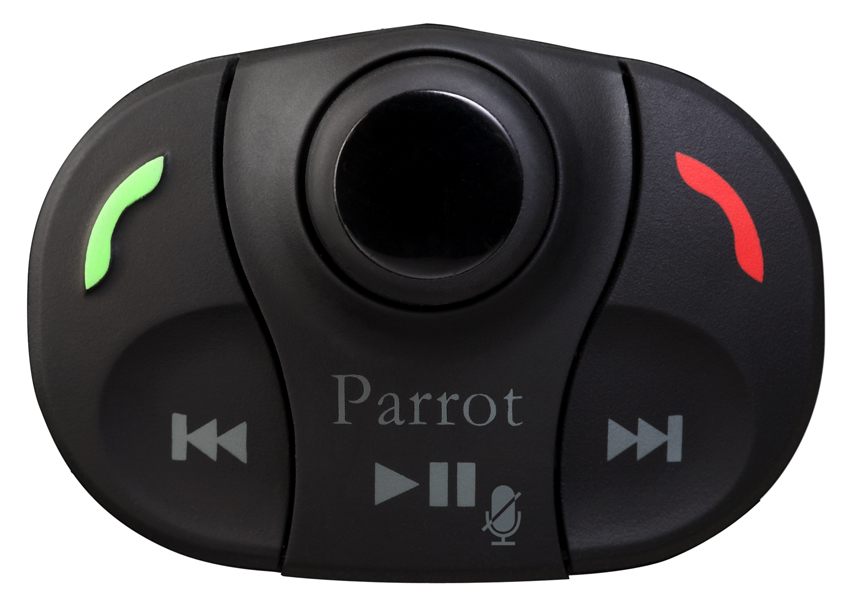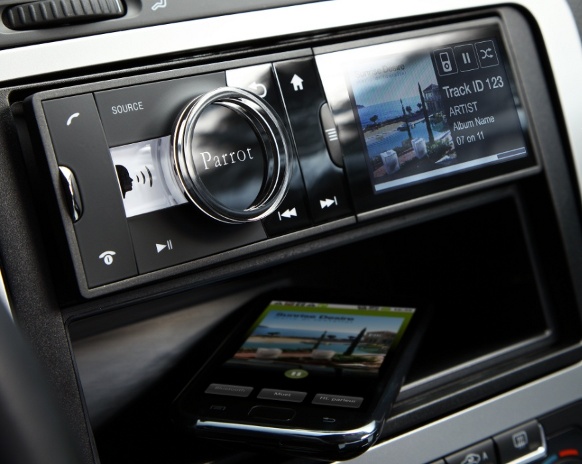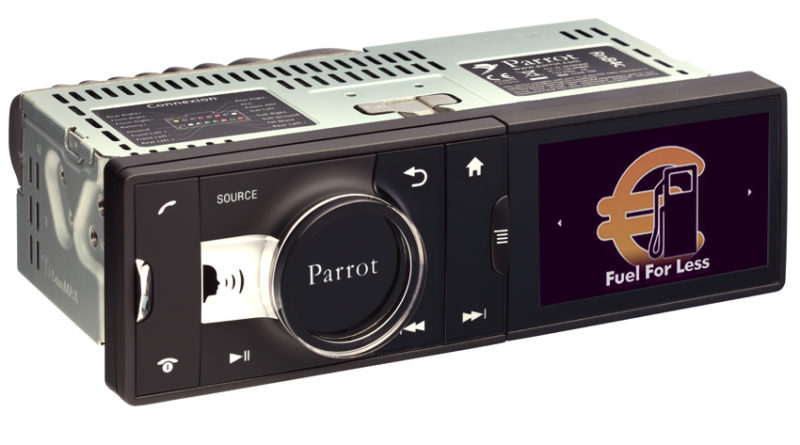Parrot ASTEROID Headunit
Product Details
Manufacturer: Parrot
Website: link
Typical Selling price: £299.99
What It Is
This is the first headunit from Parrot, who are arguably the Kings of Bluetooth Technology. Initially, most of the big Japanese car electronics companies configured and used their own Bluetooth applications. But they have all capitulated bit by bit to Parrot’s technical superiority and now pretty much all the major players have come to use Parrot Bluetooth systems as part of their own headunits as it just works better, with more phones. And now, the Parrot company has got this, the Asteroid headunit. A shallow item, with very little electronics inside, it goes back less than half as far as a normal DIN unit. But has enough gumption to boss an iPod, read a huge SD card or a USB storage stick (or my Sandisk 8GB ‘˜bean’) all at the same time as receiving stuff from the ‘˜net via a 3G dongle in yet another USB plug hole and navigate via the included GPS antenna. (Recent software upgrades now mean you can access 3G by a smart phone on USB) A video style screen and a single big control knobber you twist and pulse to do stuff completes the story. It has mighty cunning and wide compatibilities as it can run Android Apps. There’s a lot to try out on this deck and it has taken more bench time than I realised to really get to grips with. Which makes a full-on three-head Dolby B & C equipped cassette deck from the Eighties look like an Eohippus next to a race horse.
Full Specifications
General
Telephony: answer/make a call, reject/end a call, volume, double call, menus, phonebook, settings and options, play/pause, forward, backward
Software update via USB key
Android web service Apps compatible
Steering-wheel controls compatible
Removable faceplate with jog wheel
Colour screen TFT 3.2in display with 262,144 colours
Music/Radio
Vocal Music Search (Artist, Album)
Compatibility with iPod by cable, USB, SD, Line input
Virtual Superbass effect
Parametric equaliser: 7 bands, 6 defined presets, 1 user preset
FM/AM tuner with no limitation for presets
With RDS Text+- PS – TP – PTY RT
Audio/Bluetooth
Full duplex conversations
External adjustable double microphone
Parrot noise reduction NR 3.0
Echo cancellation AEC
Dispatch voice and music on car’s speakers
4 x 55W built-in MOSFET amplifier
4x USB connections (one especially for iPod/iPhone)
6x RCA pre-amp outputs (2 with subwoofer)
Bluetooth v2.1+ EDR
Profiles: HFP, Bluetooth Stereo (A2DP), OPP, PBAP, HSP,SPP and AVRCP
Pairing: via PIN code ‘˜0 0 0 0’
Phonebook management
Automatic phonebook synchronization
Synchronization: PBAP, Sync ML, OPP, Synchro AT, Synchro Nokia
Automatic connection with mobile phones
Training-free, multi user voice recognition
Voice synthesis
Text To Speech
Up to 10 paired phones
Number of contacts: up to 2,000 per phone – 8,000 in total per unit
Complete with:
1x Parrot ASTEROID unit
1x ISO cable
1x GPS receiver with USB connector
1x USB male 1.5m to USB female cable
1x iPod cable 1.2m
1x Jack cable male to male 1.5m (audio device)
1x Front Panel Bag
1x Quick start guide
3x Cables ties
1x Bracket Keys
1x Double external microphone
1x Mounting Sleeve
Editor Review : Parrot ASTEROID Headunit
How Is It Made?
I have been plugging stuff in and out of this deck and playing about with all the things it can do for longer than any head unit in my entire career! Just as well, for it took longer than any headunit in history to finally get to me as mainstream interest in the heavy duty world of Parrot business was intense. All sorts of webby folks had this first but I am as determined as ever that Talk Audio will go deeper into the beast than any other review. To do that, I may well be enlisting a long term reporter who will have to earn their chance to report on the Asteroid and then will get to add to the whole thing with their takeand to do that means they have to live with it. All of which adds up to the fact that I was told I could nick the extra-to-the-test-unit example I have here, or I could ‘˜Swag’ it out. I want to do both really but the best result for you, dear reader will be to hear another’s view as well. The long term reporter will get to keep it. For while I am a sad audio case, there may be a dude yet more geeky than I who can wrestle with the Android Software development Kit that has been made just for Asteroid and/or maybe can simply report deeper into the App side of the machine than I.
So, Parrot are the boss at Bluetooth. Yes there other players like Bury and more but the Parrot story is a killer and includes Parrot ‘˜Zikmu’ speakers designed by Philippe Starck and a flying toy of great coolness called AR Drone (2.0)that can stream HD video back to your iPlop as you fly! None of which the others get up to.
As Parrot have been making Bluetooth OEM-piggyback units for dash mounting for many years, all with buttonshere’s one of their controllers, from the MKi 900 system.
they know about the ergonomics of in car electronics, so the buttons are few, lumpen-sized big for easy use while driving and with easy to read labels. All around a central rotary knob unit that scrolls menus and has a push-to-click function much as many devices do. However, as it is made to sell at a sensible price, the hardware on the front has to be a slight compromise. The big wheel part feels a little unsubstantial and could probably do with some knurling on the edges as despite it looking cool, it can be slippy in sweaty fingers. If this was an Alpine or a Kenwood or a Pioneer, a knob this big would be one hell of an event as they would only do it to a certain quality standard of ‘˜feel’.
However, not one single iota of down-check can be allowed for this, as it is shiny, smart, the buttons do stuff when you press them (even if you are still on the learning curve and are doing the odd stupid thing) and it does light up most prettily. Incidentally, there are independent brightness controls for backlighting and screen brightness
.
The display is used as a series of information screens and in some ways the Human Machine Interface (HMI) is more reminiscent of a smartphone Android OS than a car unit HMI. It has good detail and is as big as can be fitted onto a single DIN unit without ‘˜stretching’ its face to bigger-than-DIN.
The rear panel is stiff with connectors and all need to have something stuck in them to extend the sockets to somewhere you can use them once installed. I cannot help but feel that a simple patch-panel accessory is called for say a single-DIN cubby moulding with vertical half DIN pocket and a panel next to it with all the sockets replicated as the way you are supposed to use it means either a cluster of USB sockets on trailing wires and an iPod connected USB cord, and the 3.5mm jack cord, must all hang out of a hole through your glove box or some such. That or be custom fitted to panel mounted sockets..
The removable panel has a cloth bag which would be better as a hard case, I feel. You get lots of stuff in the box though, with six cabley/antenna-ish bits like the microphone, GPS sensor and different USB wires. Yet since it is a creature of the ‘˜Net age, it does require you to go online for the manual in full. You get a start-up guide and most menu-savvy folks will eventually blunder their way into most functions. But knowing which buttons to hold for duration helps
How Well Does It Work?
OK, let’s get one great big hairy pain in the butt out of the way first. The manual clearly states that as you fire this baby up, you must not have the media file-buckets connected. Now, that’s OK for my precious iPlop. The iPod Touch 4th Gen is a happy WiFi beast in my home and anywhere I can piggy back some bandwidth. (everywhere, if I go with BT) and so it comes with me always. Bristling with apps, I stream video, watch YouTube etc, etc. So to plugging that in and out is fair game. But what of my teeny weeny 8GB Sandisk so easy to lose? No, I have to keep it safe and plug it in only after boot up and this will be after I have driven off. If you were to leave it all connected, you would have a massive, multi lobed multimedia festival of material on video and all sorts, making it one hell of a juke. But you cannot leave it like a CD changer with stuff loaded and that’s a pain in the bottom. OK, you can leave a farking he-yuge 32GB SDHC in it’s maw behind the panel, so you could call me a pedant but it’s like having extra engines you cannot use until you are driving fast enough in the first place.
Just like my PC for whom USB was created the bloody dragon has to have woken up, scratched, farted AND cleared its throat with a little cough before you can get any fire breathing.
Likewise, I refrained from getting a line from a hard drive and trying to connect a monster file. I have a contact that writes software for the Open University and he uses a small HDD in his car and wonders why it won’t work on all decks. It’s nicknamed the Genghis File and is 75.3GB. It’s a lot of music. So, I’ll not rant on about the files it can or can’t handle for there were a cluster of different things I used.
I tried the iPod. A Sony MP3 Walkman on a 3.5mm jack; the Sandisk 8GB ‘˜bean; a selection of other USB sticks and the SD card. I made phone calls and I had a bit of A2DP music streaming action, although that tool some digging into menus of both BlackBerry and Asteroid to sort out.
The speed of control was impressive. The amount of music you could have at your fingertips was brilliant and the use of the tracks’ metadata (all that background labelly stuff you normally don’t see you want to realise how much is on a digital camera shot, f’rinstance!) was fabulous. It was a bit iPod like, even when it was just on a USB.
I barely tickled the voice recognition but it was even better than the no-training VR on the new BB operating system I have and I gather from a long term user who has had one in the dash for six months, that you end up just talking to it to ask for stuff.
It’s the kind of unit that could be written about for ever and more than one how to video exists. This one is good for the apps side of things. Just check out the maps stuff here:
And my home test bench location is ‘˜On a Mountain’ according to the broadcasters, making it a fabulous Amateur radio location and good for testing ancient tech FM radios and TV receivers for sensitivity but crap for testing 3G functions. So at this point and more than two thousand words, I think we aught publish with just how clever this thing is and we can revisit and add some long-term stuff as edits later.
But I can tell you that once you have your head around the slightly different modus operandi of the thing, then you will be fine. It’s a bit like the Citroen Berlingo I was struggling with in Spain on Holiday. I suddenly realised, exclaimed, ‘It’s a Vaaaaaaaayen!’ and then drove it like one and all was serene. This is a USP and GPS tour de force that can harness the Android robot for you and makes a mere music playing radio deck look a bit primitive! I love this thing and will be taking a very old deck from my very own dash and changing it for this for a while. I hope to keep to my promise to swag it onwards to a helpful writer-aide later but I may just have an attack of covetousness.
I’ll let you know.
Overall 8.8
Sound Quality 8
Appearance/Display 8
Ease Of Use/HMI 8
Features 10
Value For Money 10
In A Nutshell
The true First Of Breed and as such, in the way a Blu-Ray player brings amazing images and a bit of a wait while the essentially PC-like insides boots up, the Asteroid can take a bit of booting up time and then is able to deliver the ocean to your lips, all via an HMI designed for the road. Absolutely the way of the future and it’s here now, freshly sexified with a new software update. A geek’s delight yet easy enough for reasonably ept computer users to hugely enjoy.
Happily Recommended by Talk Audio.
Now, can anyone write Android Apps? link

